Abstract
Studies were conducted to investigate the survival and multiplication of Legionella spp. in public drinking water supplies. An attempt was made, over a period of several years, to isolate legionellae from a municipal system. Sampling sites included the river water supply, treatment plant, finished water reservoir system, mains, and distribution taps. Despite the use of several isolation techniques, Legionella spp. could not be detected in any of the samples other than those collected from the river. It was hypothesized that this was due to the maintenance of a chlorine residual throughout the system. To investigate the potential for Legionella growth, additional water samples, collected from throughout the system, were dechlorinated, pasteurized, and inoculated with Legionella pneumophila. Subsequent growth indicated that many of these samples, especially those collected from areas affected by an accumulation of algal materials, exhibited a much greater ability to support Legionella multiplication than did river water prior to treatment. Chemical analyses were also performed on these samples. Correlation of chemical data and experimental growth results indicated that the chemical environment significantly affects the ability of the water to support multiplication, with turbidity, organic carbon, and certain metals being of particular importance. These studies indicate that the potential exists for Legionella growth within municipal systems and support the hypothesis that public water supplies may contaminate the plumbing systems of hospitals and other large buildings. The results also suggest that useful methods to control this contamination include adequate treatment plant filtration, maintenance of a chlorine residual throughout the treatment and distribution network, and effective covering of open reservoirs.
Full text
PDF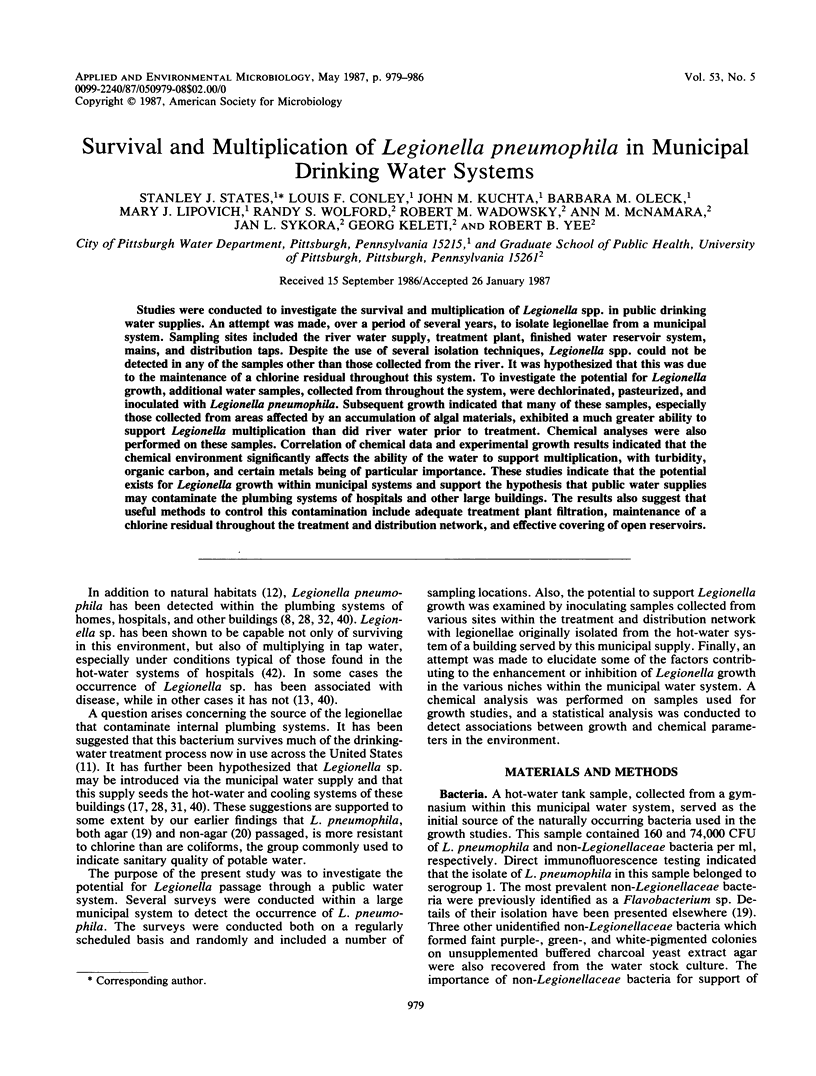
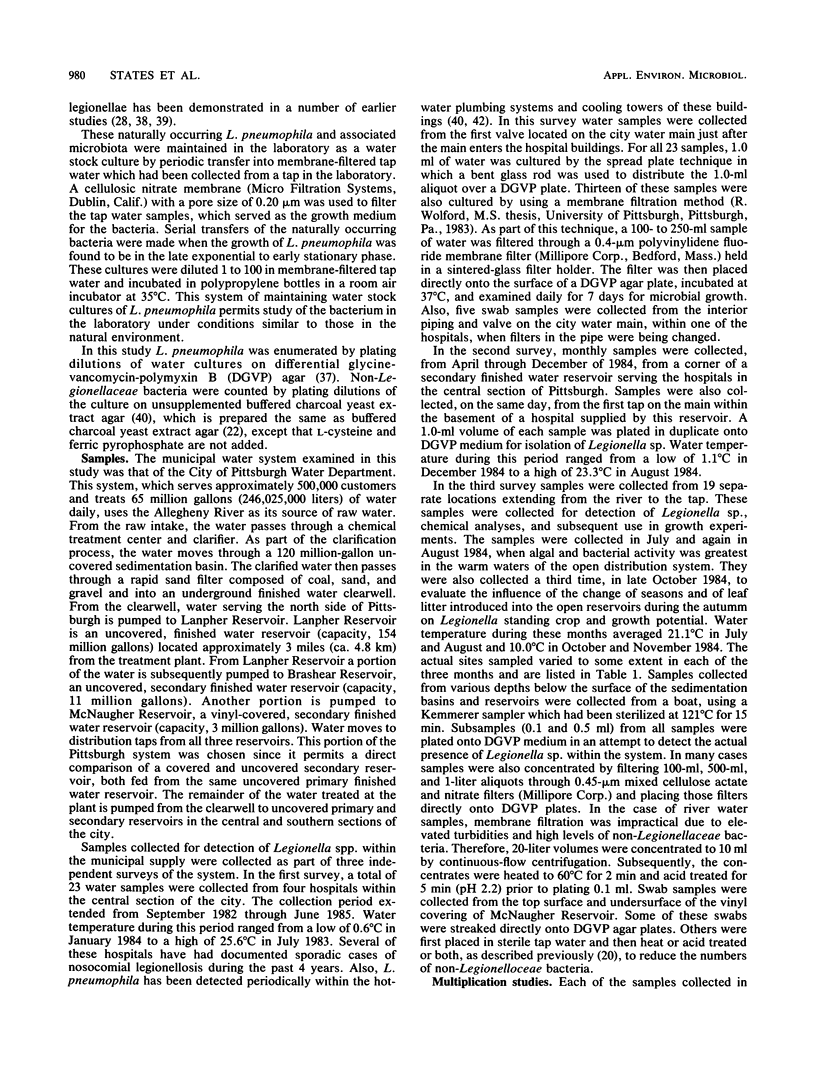
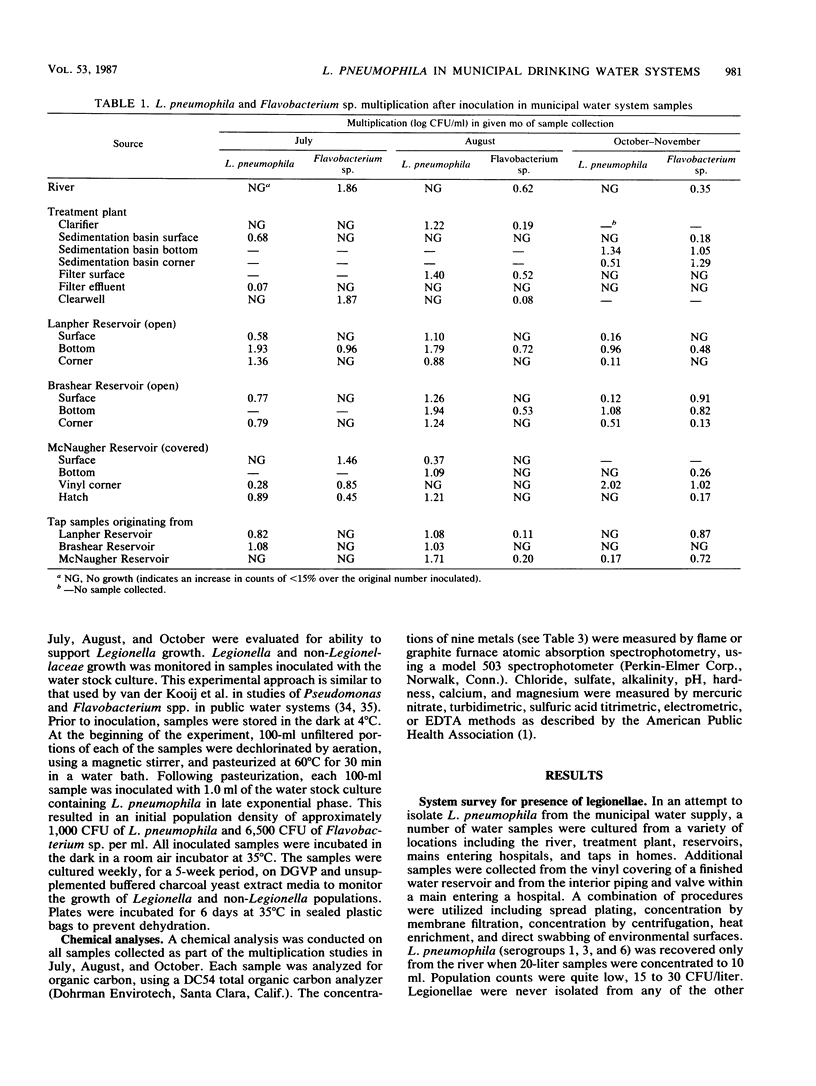
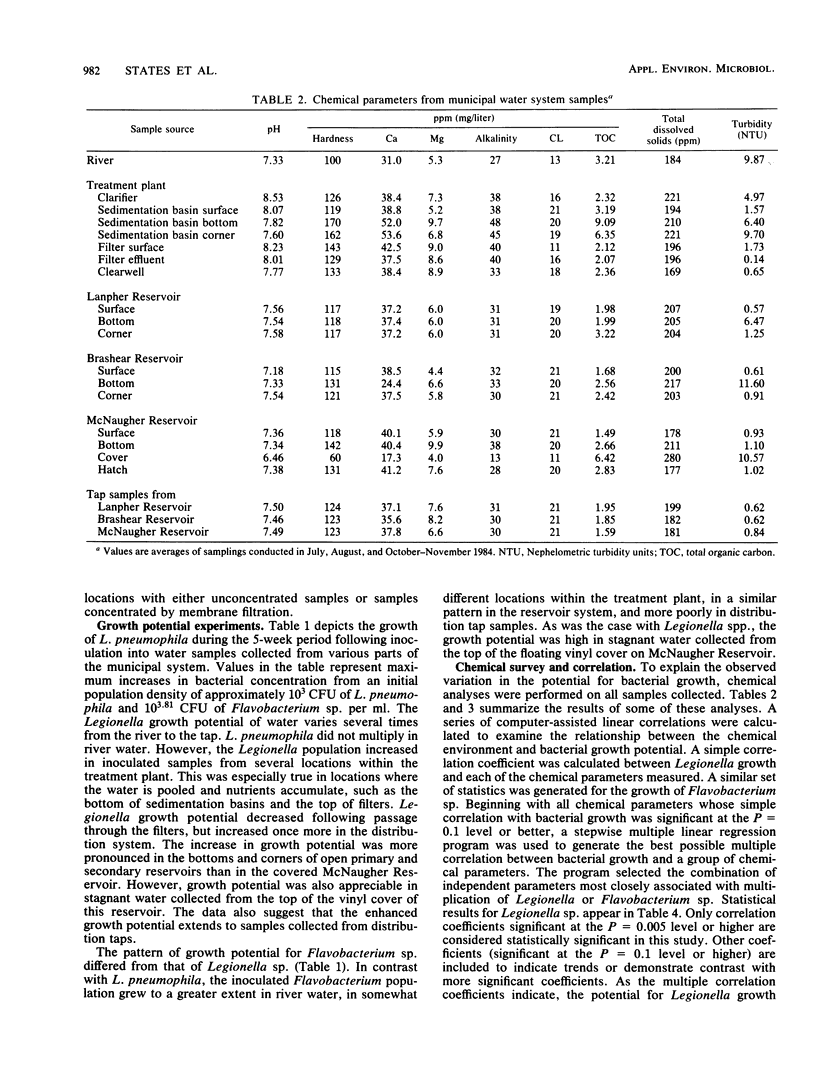
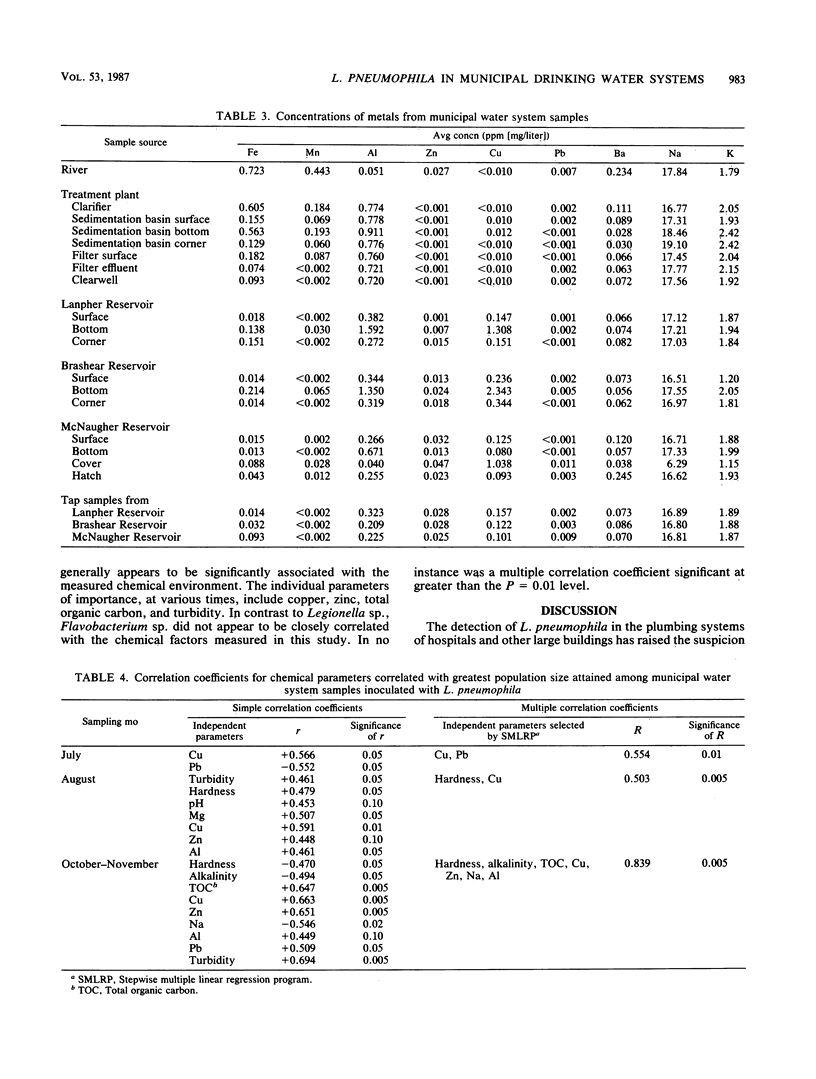
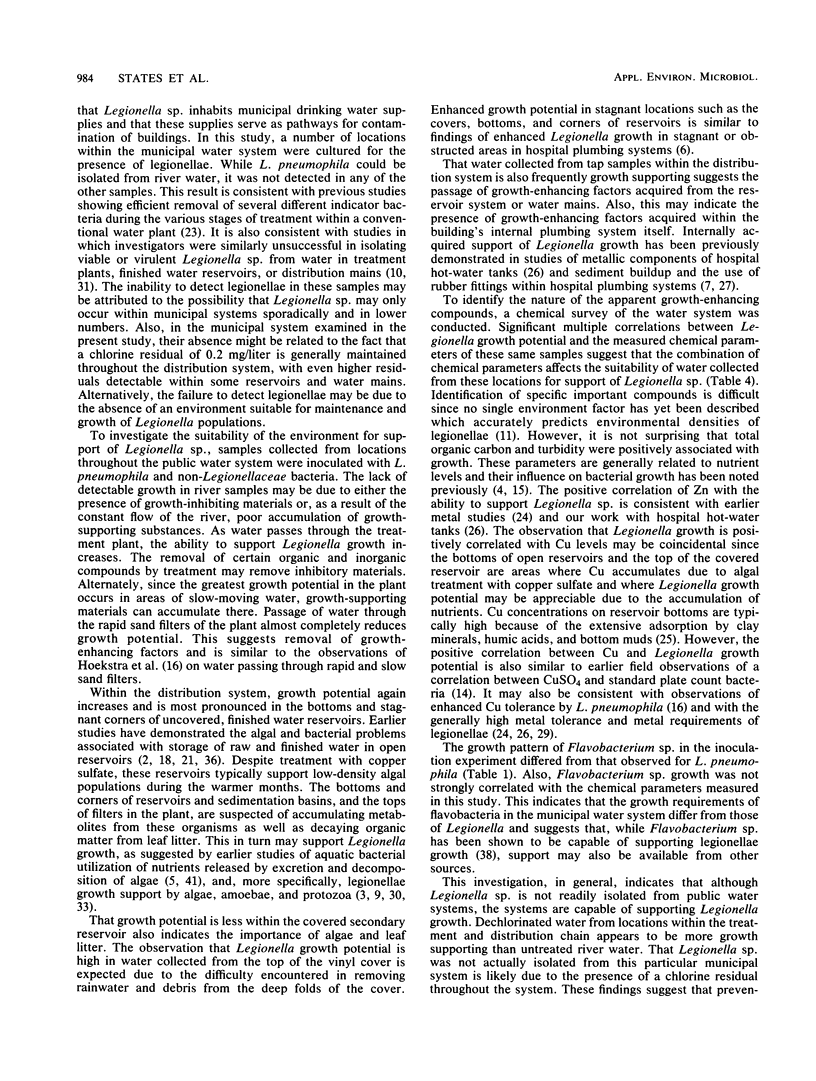

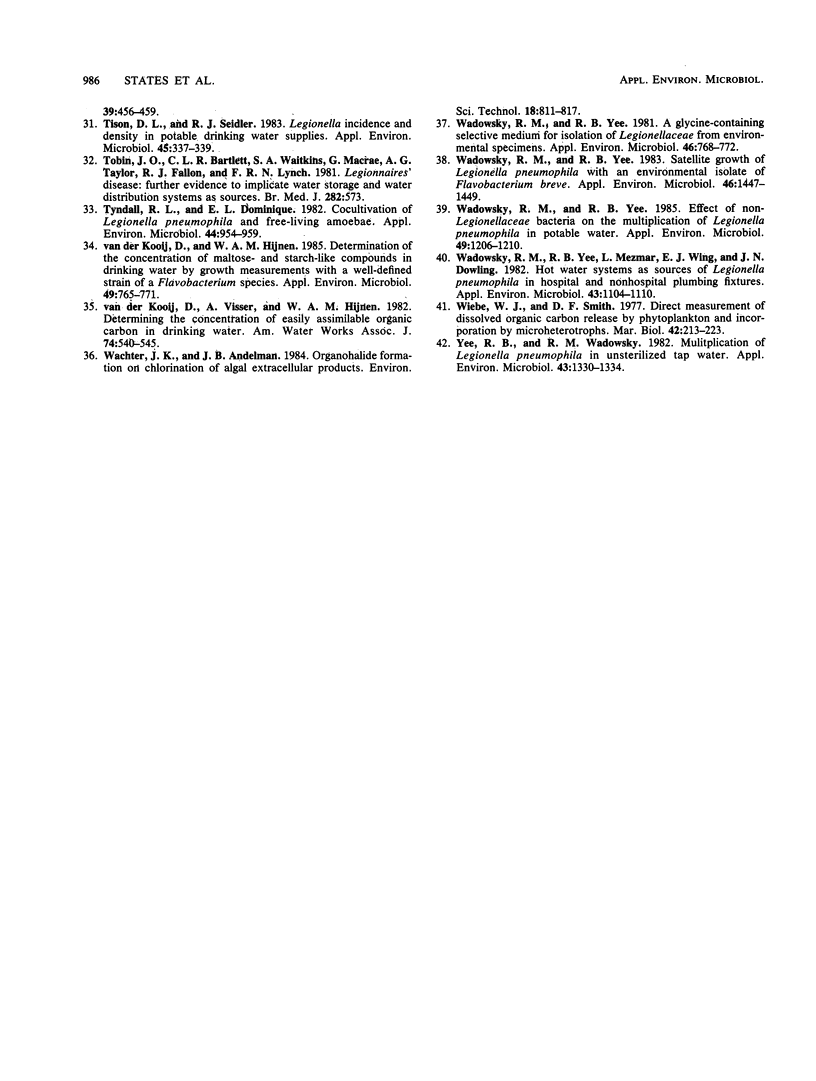
Selected References
These references are in PubMed. This may not be the complete list of references from this article.
- Bohach G. A., Snyder I. S. Cyanobacterial stimulation of growth and oxygen uptake by Legionella pneumophila. Appl Environ Microbiol. 1983 Aug;46(2):528–531. doi: 10.1128/aem.46.2.528-531.1983. [DOI] [PMC free article] [PubMed] [Google Scholar]
- Boylen C. W., Shick M. O., Roberts D. A., Singer R. Microbiological Survey of Adirondack Lakes with Various pH Values. Appl Environ Microbiol. 1983 May;45(5):1538–1544. doi: 10.1128/aem.45.5.1538-1544.1983. [DOI] [PMC free article] [PubMed] [Google Scholar]
- Brock T. D., Clyne J. Significance of algal excretory products for growth of epilimnetic bacteria. Appl Environ Microbiol. 1984 Apr;47(4):731–734. doi: 10.1128/aem.47.4.731-734.1984. [DOI] [PMC free article] [PubMed] [Google Scholar]
- Ciesielski C. A., Blaser M. J., Wang W. L. Role of stagnation and obstruction of water flow in isolation of Legionella pneumophila from hospital plumbing. Appl Environ Microbiol. 1984 Nov;48(5):984–987. doi: 10.1128/aem.48.5.984-987.1984. [DOI] [PMC free article] [PubMed] [Google Scholar]
- Dennis P. J., Taylor J. A., Fitzgeorge R. B., Bartlett C. L., Barrow G. I. Legionella pneumophila in water plumbing systems. Lancet. 1982 Apr 24;1(8278):949–951. doi: 10.1016/s0140-6736(82)91944-4. [DOI] [PubMed] [Google Scholar]
- Fields B. S., Shotts E. B., Jr, Feeley J. C., Gorman G. W., Martin W. T. Proliferation of Legionella pneumophila as an intracellular parasite of the ciliated protozoan Tetrahymena pyriformis. Appl Environ Microbiol. 1984 Mar;47(3):467–471. doi: 10.1128/aem.47.3.467-471.1984. [DOI] [PMC free article] [PubMed] [Google Scholar]
- Fisher-Hoch S. P., Bartlett C. L., Tobin J. O., Gillett M. B., Nelson A. M., Pritchard J. E., Smith M. G., Swann R. A., Talbot J. M., Thomas J. A. Investigation and control of an outbreaks of legionnaires' disease in a district general hospital. Lancet. 1981 Apr 25;1(8226):932–936. doi: 10.1016/s0140-6736(81)91626-3. [DOI] [PubMed] [Google Scholar]
- Fliermans C. B., Cherry W. B., Orrison L. H., Smith S. J., Tison D. L., Pope D. H. Ecological distribution of Legionella pneumophila. Appl Environ Microbiol. 1981 Jan;41(1):9–16. doi: 10.1128/aem.41.1.9-16.1981. [DOI] [PMC free article] [PubMed] [Google Scholar]
- Fliermans C. B., Cherry W. B., Orrison L. H., Thacker L. Isolation of Legionella pneumophila from nonepidemic-related aquatic habitats. Appl Environ Microbiol. 1979 Jun;37(6):1239–1242. doi: 10.1128/aem.37.6.1239-1242.1979. [DOI] [PMC free article] [PubMed] [Google Scholar]
- Hsu S. C., Martin R., Wentworth B. B. Isolation of Legionella species from drinking water. Appl Environ Microbiol. 1984 Oct;48(4):830–832. doi: 10.1128/aem.48.4.830-832.1984. [DOI] [PMC free article] [PubMed] [Google Scholar]
- Kuchta J. M., States S. J., McGlaughlin J. E., Overmeyer J. H., Wadowsky R. M., McNamara A. M., Wolford R. S., Yee R. B. Enhanced chlorine resistance of tap water-adapted Legionella pneumophila as compared with agar medium-passaged strains. Appl Environ Microbiol. 1985 Jul;50(1):21–26. doi: 10.1128/aem.50.1.21-26.1985. [DOI] [PMC free article] [PubMed] [Google Scholar]
- Kuchta J. M., States S. J., McNamara A. M., Wadowsky R. M., Yee R. B. Susceptibility of Legionella pneumophila to chlorine in tap water. Appl Environ Microbiol. 1983 Nov;46(5):1134–1139. doi: 10.1128/aem.46.5.1134-1139.1983. [DOI] [PMC free article] [PubMed] [Google Scholar]
- Pasculle A. W., Feeley J. C., Gibson R. J., Cordes L. G., Myerowitz R. L., Patton C. M., Gorman G. W., Carmack C. L., Ezzell J. W., Dowling J. N. Pittsburgh pneumonia agent: direct isolation from human lung tissue. J Infect Dis. 1980 Jun;141(6):727–732. doi: 10.1093/infdis/141.6.727. [DOI] [PubMed] [Google Scholar]
- Payment P., Trudel M., Plante R. Elimination of viruses and indicator bacteria at each step of treatment during preparation of drinking water at seven water treatment plants. Appl Environ Microbiol. 1985 Jun;49(6):1418–1428. doi: 10.1128/aem.49.6.1418-1428.1985. [DOI] [PMC free article] [PubMed] [Google Scholar]
- Reeves M. W., Pine L., Hutner S. H., George J. R., Harrell W. K. Metal requirements of Legionella pneumophila. J Clin Microbiol. 1981 Apr;13(4):688–695. doi: 10.1128/jcm.13.4.688-695.1981. [DOI] [PMC free article] [PubMed] [Google Scholar]
- States S. J., Conley L. F., Ceraso M., Stephenson T. E., Wolford R. S., Wadowsky R. M., McNamara A. M., Yee R. B. Effects of metals on Legionella pneumophila growth in drinking water plumbing systems. Appl Environ Microbiol. 1985 Nov;50(5):1149–1154. doi: 10.1128/aem.50.5.1149-1154.1985. [DOI] [PMC free article] [PubMed] [Google Scholar]
- Stout J. E., Yu V. L., Best M. G. Ecology of Legionella pneumophila within water distribution systems. Appl Environ Microbiol. 1985 Jan;49(1):221–228. doi: 10.1128/aem.49.1.221-228.1985. [DOI] [PMC free article] [PubMed] [Google Scholar]
- Stout J., Yu V. L., Vickers R. M., Zuravleff J., Best M., Brown A., Yee R. B., Wadowsky R. Ubiquitousness of Legionella pneumophila in the water supply of a hospital with endemic Legionnaires' disease. N Engl J Med. 1982 Feb 25;306(8):466–468. doi: 10.1056/NEJM198202253060807. [DOI] [PubMed] [Google Scholar]
- Tesh M. J., Miller R. D. Growth of Legionella pneumophila in defined media: requirement for magnesium and potassium. Can J Microbiol. 1982 Sep;28(9):1055–1058. doi: 10.1139/m82-158. [DOI] [PubMed] [Google Scholar]
- Tison D. L., Seidler R. J. Legionella incidence and density in potable drinking water supplies. Appl Environ Microbiol. 1983 Jan;45(1):337–339. doi: 10.1128/aem.45.1.337-339.1983. [DOI] [PMC free article] [PubMed] [Google Scholar]
- Tobin J. O., Bartlett C. L., Waitkins S. A., Barrow G. I., Macrae A. D., Taylor A. G., Fallon R. J., Lynch F. R. Legionnaires' disease: further evidence to implicate water storage and distribution systems as sources. Br Med J (Clin Res Ed) 1981 Feb 14;282(6263):573–573. doi: 10.1136/bmj.282.6263.573. [DOI] [PMC free article] [PubMed] [Google Scholar]
- Tyndall R. L., Domingue E. L. Cocultivation of Legionella pneumophila and free-living amoebae. Appl Environ Microbiol. 1982 Oct;44(4):954–959. doi: 10.1128/aem.44.4.954-959.1982. [DOI] [PMC free article] [PubMed] [Google Scholar]
- Wadowsky R. M., Yee R. B. Effect of non-Legionellaceae bacteria on the multiplication of Legionella pneumophila in potable water. Appl Environ Microbiol. 1985 May;49(5):1206–1210. doi: 10.1128/aem.49.5.1206-1210.1985. [DOI] [PMC free article] [PubMed] [Google Scholar]
- Wadowsky R. M., Yee R. B. Glycine-containing selective medium for isolation of Legionellaceae from environmental specimens. Appl Environ Microbiol. 1981 Nov;42(5):768–772. doi: 10.1128/aem.42.5.768-772.1981. [DOI] [PMC free article] [PubMed] [Google Scholar]
- Wadowsky R. M., Yee R. B., Mezmar L., Wing E. J., Dowling J. N. Hot water systems as sources of Legionella pneumophila in hospital and nonhospital plumbing fixtures. Appl Environ Microbiol. 1982 May;43(5):1104–1110. doi: 10.1128/aem.43.5.1104-1110.1982. [DOI] [PMC free article] [PubMed] [Google Scholar]
- Wadowsky R. M., Yee R. B. Satellite growth of Legionella pneumophila with an environmental isolate of Flavobacterium breve. Appl Environ Microbiol. 1983 Dec;46(6):1447–1449. doi: 10.1128/aem.46.6.1447-1449.1983. [DOI] [PMC free article] [PubMed] [Google Scholar]
- Yee R. B., Wadowsky R. M. Multiplication of Legionella pneumophila in unsterilized tap water. Appl Environ Microbiol. 1982 Jun;43(6):1330–1334. doi: 10.1128/aem.43.6.1330-1334.1982. [DOI] [PMC free article] [PubMed] [Google Scholar]
- van der Kooij D., Hijnen W. A. Determination of the concentration of maltose- and starch-like compounds in drinking water by growth measurements with a well-defined strain of a Flavobacterium species. Appl Environ Microbiol. 1985 Apr;49(4):765–771. doi: 10.1128/aem.49.4.765-771.1985. [DOI] [PMC free article] [PubMed] [Google Scholar]


